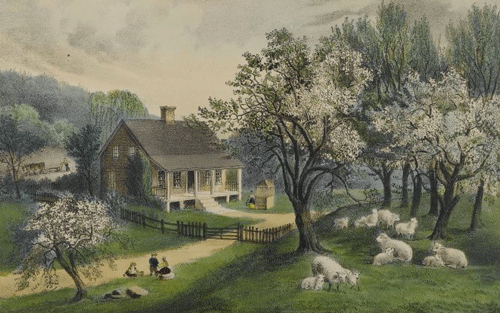The Morris Canal at Waterloo Village Historic Site is a restored 19th century canal town in Byram Township, Sussex County in northwestern New Jersey. The community was approximately the half-way point in the roughly 102-mile (165 km) trip along the Morris Canal, which ran from Jersey City, NJ across New Jersey to Phillipsburg, PA
Waterloo Village mill town possessed all the accommodations necessary to service the needs of a canal operation, including an inn, a general store, a church and a blacksmith shop (to service the mules on the canal), and a gristmill. Waterloo's geographic location would have been conducive to being an overnight stopover point on the two-day trip between Phillipsburg and Jersey City.
The Rutan Cabin (c.1825) was relocated from its original site in Frankford Township to prevent its loss to developers. This structure is actually a combination of two different log buildings, with a common loft.
 American Homestead Spring (Courier and Ives)
American Homestead Spring (Courier and Ives)
Most of the people in Colonial America lived and worked on a farm. Life for the average family was very hard and they had to work hard all year long just to survive. A typical day on the farm started early in the morning as soon as the sun began to rise. Farmers needed to take advantage of every minute of daylight to finish their work. The family would have a quick breakfast of porridge and beer and then everyone would go to work.
The men worked outside on the farm and the fields. What they did depended on the time of year. During the spring they would be tilling and planting the fields. They had to do all the work by hand or with the help of an ox or horse. During the fall they had to gather the harvest. The rest of the time they tended the fields, took care of their livestock, chopped wood, fixed fences, and repaired the house. There was always more work to do.
The women worked every bit as hard as the men. They prepared the meals, sewed and mended the clothing, made candles, managed the garden, prepared food for the winter, wove cloth, and raised the children.
Most children were put to work as soon as they were able. In many ways children were seen as laborers for the family. The boys helped the father with his work and the girls helped their mother. This way they also learned the skills they would need when they grew up. In most areas there wasn't a public school, so many farm children did not get any formal education. Boys often learned how to read or write from their father or the local minister. Girls were often not taught to read or write at all. The boys usually attended longer as it was considered more important for them to learn to read and write so they could manage the farm.